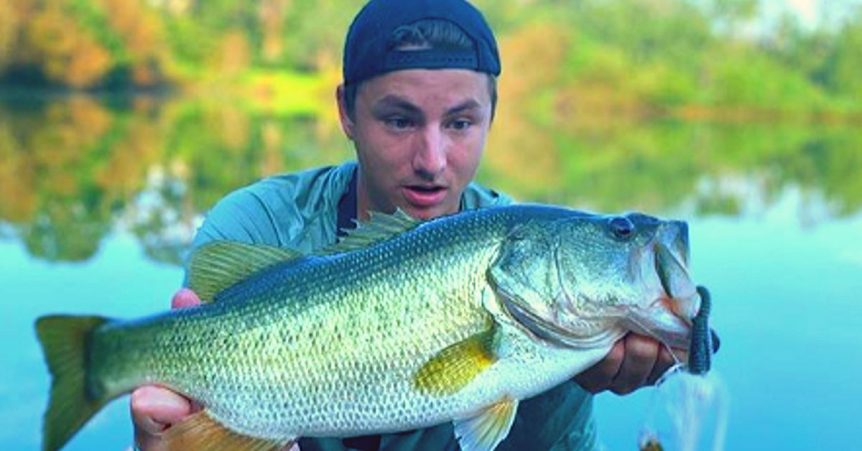Clear Water Tricks For Foolin’ Fall Fatties
When conditions are right, deep, clear lakes offer typical shallow-water action for bass in the fall.
However, fall’s constantly changing weather can cause bass to quickly advance to or retreat from the shallows. The changing weather conditions can frustrate anglers who depend on a “here today, gone tomorrow” pattern for catching bass in thin water. For more consistent action on clear lakes, savvy anglers probe deeper water throughout the fall.
The depth of bass on clear lakes during the fall depends on the thermocline. On some clear-water reservoirs the thermocline will be 22 to 32 feet deep when the water starts to cool. In early fall baitfish start bunching up in the thermocline before migrating into the creeks. Once the baitfish congregate on the main lake, bass also start grouping up and become easier to locate.

Keying on a creek or river channel also helps pinpoint bass during early autumn. An ideal spot is a point where there is a feeder creek on one side and the main channel on the other side so there is good depth on both sides of the point.
Bass on the points hug the bottom near break lines or move out into open water and suspend. If baitfish are also suspended in the open water, you can get into some fast action when the bass go into a feeding frenzy. Clear-water experts rely heavily on their electronics to catch both suspending and bottom-hugging bass from the deep. Manually setting the sensitivity of their sonar units allows them to detect their lures and fish movement. They can drop a plastic grub or spoon down to the fish and watch their screen for bass streaking up to the lure.

This vertical fishing tactic works best on bright, bluebird sky days. In the morning you can start with a topwater lure and look for surface activity along main lake points and channel swings. Once the surface action ceases, you can break out the spinning tackle and drop a 4-inch finesse worm on a 3/16- or 1/4-ounce darter jighead to the suspended fish. A curly-tail 4-inch plastic grub is another productive lure to vertical jig for suspended bass.
Suspended bass usually require some coaxing to entice them to bite. Try shaking the worm about 4 to 5 feet above the fish by popping your rod about 2 to 3 inches and then let it sit for a second before shaking the worm again. The shaking worm imitates the darting action of a small shad. You can also raise your rod tip a couple of feet and let the lure fall to entice bass into biting. When vertical jigging with the plastic grub, frequently lift your rod tip about 6 to 8 inches to help you detect strikes from bass suspended deeper in the water column.
Another effective lure for suspended bass is a jigging spoon. You can catch bass a lot faster with a spoon if you find more aggressive fish. A 3/4-ounce slab spoon in chrome or white presented on 15-pound test line works best in the clear water.

Drop your spoon below the schools of shad you see on your electronics and then jerk your rod up about 3 or 4 feet at a time. Watch your line closely as you let the spoon drop because most of the time bass will hit the spoon on the fall. If the line stops falling and you see a slight twitch in the line, set the hook because a bass has inhaled the spoon. Jerking the rod during the retrieve also allows you to set the hook even if you miss seeing the strike.
When suspended bass ignore your offerings try a bottom-bouncing tactic to catch deep bass on points and flats. Select a 3/4-ounce football jig tipped with a twin-tail plastic grub or a plastic craw and steadily drag the lure along the bottom. The jig bouncing along the bottom imitates the crawling action of a crawfish, another favorite forage of bass in the fall.

As shad migrate to the creeks later in autumn, bass suspend under the baitfish in the middle of the creeks at depths ranging from 10 to 25 feet. A 3/4-ounce spinnerbait with tandem willowleaf blades is a good choice for catching these suspended fish.
When you spot a large school of baitfish flicking on the surface, make a long cast and let your spinnerbait flutter right through the shad. The spinnerbait will bounce off the backs of the shad and when the lure stops bumping the baitfish, start retrieving it in a yo-yo fashion by pumping up your rod and reeling in the slack. Slow-rolling the spinnerbait just under the shad balls also catches quality bass in the creeks. If bass ignore your spinnerbait, try yo-yoing a smaller tailspinner through the baitfish.
How useful was this post?
Click on a star to rate it!
Average rating 4.8 / 5. Vote count: 8



